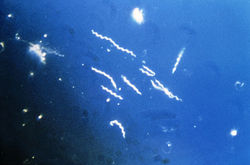Difference between revisions of "Borrelia burgdorferi"
m (Text replace - "[[Lyme disease" to "[[Lyme Disease") |
|||
| Line 34: | Line 34: | ||
[http://www.cabdirect.org/search.html?rowId=1&options1=AND&q1=%22Borrelia+burgdorferi%22&occuring1=title&rowId=2&options2=AND&q2=&occuring2=freetext&rowId=3&options3=AND&q3=&occuring3=freetext&publishedstart=2000&publishedend=yyyy&calendarInput=yyyy-mm-dd&la=any&it=any&show=all&x=46&y=10 ''Borrelia burgdorferi'' publications since 2000] | [http://www.cabdirect.org/search.html?rowId=1&options1=AND&q1=%22Borrelia+burgdorferi%22&occuring1=title&rowId=2&options2=AND&q2=&occuring2=freetext&rowId=3&options3=AND&q3=&occuring3=freetext&publishedstart=2000&publishedend=yyyy&calendarInput=yyyy-mm-dd&la=any&it=any&show=all&x=46&y=10 ''Borrelia burgdorferi'' publications since 2000] | ||
| − | [[Category:Borrelia species]][[Category:Dog Bacteria]][[Category:Horse Bacteria]][[Category:Cattle]][[Category:Sheep]] | + | [[Category:Borrelia species]][[Category:Dog Bacteria]][[Category:Horse Bacteria]][[Category:Cattle Bacteria]][[Category:Sheep Bacteria]] |
[[Category:Expert_Review]] | [[Category:Expert_Review]] | ||
Revision as of 18:58, 10 January 2011
| This article has been peer reviewed but is awaiting expert review. If you would like to help with this, please see more information about expert reviewing. |
| Borrelia burgdorferi | |
|---|---|
| Phylum | Spirochaetes |
| Class | Spirochaetes |
| Order | Spirochaetales |
| Family | Spirochaetaceae |
| Genus | Borrelia |
| Species | B. burgdorferi |
Borrelia burgdorferi is a species of Borrelia bacteria. Borrelia species are longer, wider, helical spirochaetes.
The Borrelia burgdorferi sensu lato complex is the cause of Lyme Disease. In the USA it is the Borrelia burgdorferi sensu stricto that is the most common cause of canine Lyme disease.
The bacteria are reported to infect humans, dogs, horses, cattle, sheep.
Bacteria may be cultured in Barbour-Stoenner-Kelly medium after 6 weeks under microaerophilic conditions. The best samples for culture are skin samples from near to the site of tick attachment (as the bacteria remain within the local connective tissues) but the test is not sensitive as the bacteria will be present in low numbers.
Ticks are the vector for Lyme Disease, in particular, Ixodes spp..
Literature Search
Use these links to find recent scientific publications via CAB Abstracts (log in required unless accessing from a subscribing organisation).
Borrelia burgdorferi publications since 2000

